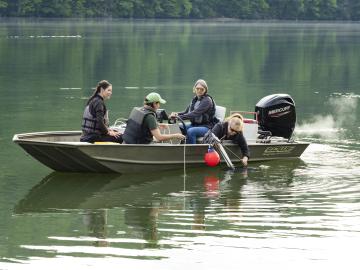
Filter News
Area of Research
- (-) Biology and Environment (177)
- (-) Fusion and Fission (54)
- (-) Neutron Science (190)
- Advanced Manufacturing (34)
- Biological Systems (18)
- Biology and Soft Matter (5)
- Building Technologies (12)
- Chemical and Engineering Materials (4)
- Chemistry and Physics at Interfaces (11)
- Clean Energy (522)
- Climate and Environmental Systems (14)
- Computational Biology (6)
- Computational Chemistry (5)
- Computational Engineering (5)
- Computer Science (19)
- Data (1)
- Earth Sciences (1)
- Electricity and Smart Grid (3)
- Energy Frontier Research Centers (14)
- Energy Sciences (5)
- Fossil Energy (3)
- Fuel Cycle Science and Technology (3)
- Functional Materials for Energy (16)
- Fusion Energy (17)
- Geographic Information Science and Technology (3)
- Isotope Development and Production (3)
- Isotopes (35)
- Materials (433)
- Materials Characterization (2)
- Materials for Computing (36)
- Materials Synthesis from Atoms to Systems (13)
- Materials Under Extremes (12)
- Mathematics (1)
- National Security (79)
- Neutron Data Analysis and Visualization (4)
- Nuclear Science and Technology (74)
- Nuclear Systems Modeling, Simulation and Validation (3)
- Nuclear Systems Technology (1)
- Quantum Condensed Matter (4)
- Quantum information Science (9)
- Reactor Technology (1)
- Renewable Energy (4)
- Sensors and Controls (5)
- Supercomputing (311)
- Transportation Systems (11)
News Type
News Topics
- 3-D Printing/Advanced Manufacturing (17)
- Advanced Reactors (8)
- Artificial Intelligence (15)
- Big Data (10)
- Bioenergy (51)
- Biology (75)
- Biomedical (27)
- Biotechnology (13)
- Buildings (3)
- Chemical Sciences (17)
- Clean Water (13)
- Climate Change (41)
- Composites (6)
- Computer Science (31)
- Coronavirus (18)
- Critical Materials (2)
- Cybersecurity (1)
- Decarbonization (23)
- Energy Storage (16)
- Environment (98)
- Exascale Computing (5)
- Fossil Energy (2)
- Frontier (5)
- Fusion (22)
- Grid (5)
- High-Performance Computing (23)
- Hydropower (8)
- Isotopes (3)
- ITER (6)
- Machine Learning (10)
- Materials (25)
- Materials Science (29)
- Mathematics (3)
- Mercury (7)
- Microscopy (14)
- Molten Salt (1)
- Nanotechnology (18)
- National Security (5)
- Net Zero (3)
- Neutron Science (99)
- Nuclear Energy (30)
- Partnerships (8)
- Physics (12)
- Polymers (3)
- Quantum Computing (1)
- Quantum Science (7)
- Renewable Energy (1)
- Security (4)
- Simulation (17)
- Space Exploration (3)
- Summit (15)
- Sustainable Energy (35)
- Transformational Challenge Reactor (1)
- Transportation (10)
Media Contacts

Griffiths and her colleagues are examining how much methane and carbon dioxide is released from the reservoir. Their aim is to better understand and predict how much of these climate-warming gases are coming from reservoirs across the nation.

While completing his undergraduate studies in the Philippines, atmospheric chemist Christian Salvador caught a glimpse of the horizon. What he saw concerned him: a thin, black line hovering above the city.

Scientists at ORNL used their expertise in quantum biology, artificial intelligence and bioengineering to improve how CRISPR Cas9 genome editing tools work on organisms like microbes that can be modified to produce renewable fuels and chemicals.

A type of peat moss has surprised scientists with its climate resilience: Sphagnum divinum is actively speciating in response to hot, dry conditions.

In fiscal year 2023 — Oct. 1–Sept. 30, 2023 — Oak Ridge National Laboratory was awarded more than $8 million in technology maturation funding through the Department of Energy’s Technology Commercialization Fund, or TCF.

The heat is on at this year’s Molten Salt Reactor Workshop – where top research and industry minds are melding to advance development on molten salt technology – at ORNL.

Currently, the biggest hurdle for electric vehicles, or EVs, is the development of advanced battery technology to extend driving range, safety and reliability.

The Department of Energy’s Oak Ridge National Laboratory hosted the second 2023 cohort of the International Atomic Energy Agency’s Lise Meitner Programme in October.

Using neutrons to see the additive manufacturing process at the atomic level, scientists have shown that they can measure strain in a material as it evolves and track how atoms move in response to stress.

ORNL will lead three new DOE-funded projects designed to bring fusion energy to the grid on a rapid timescale.


